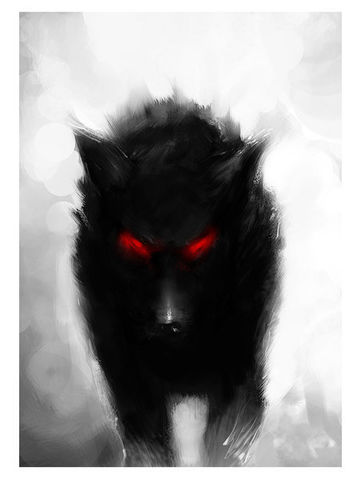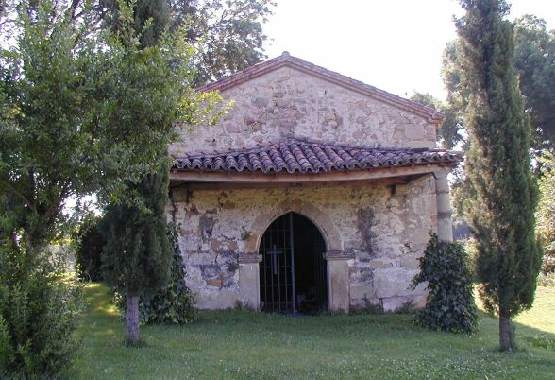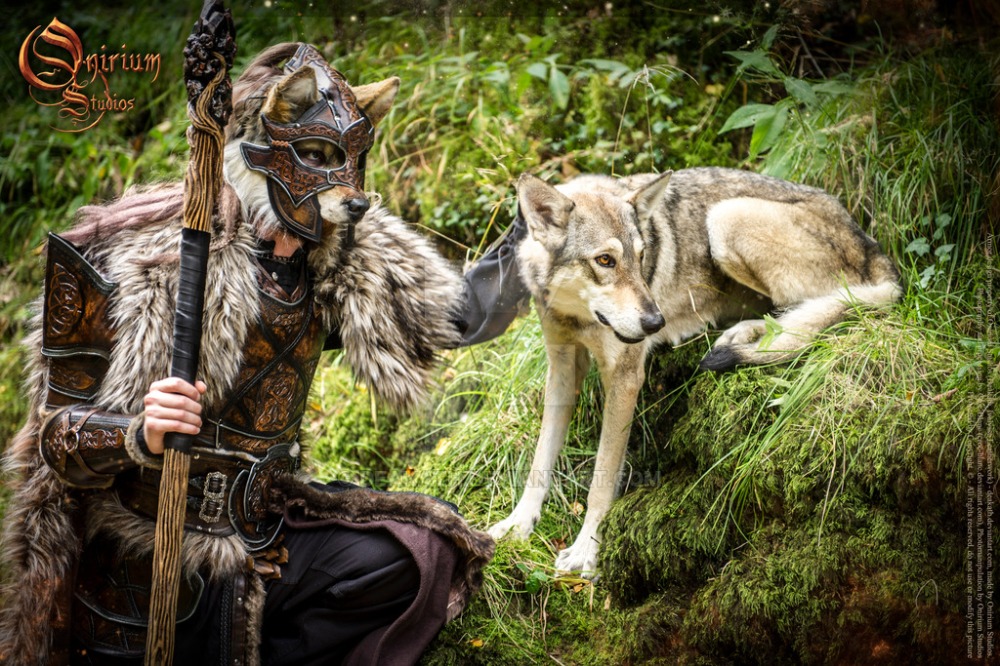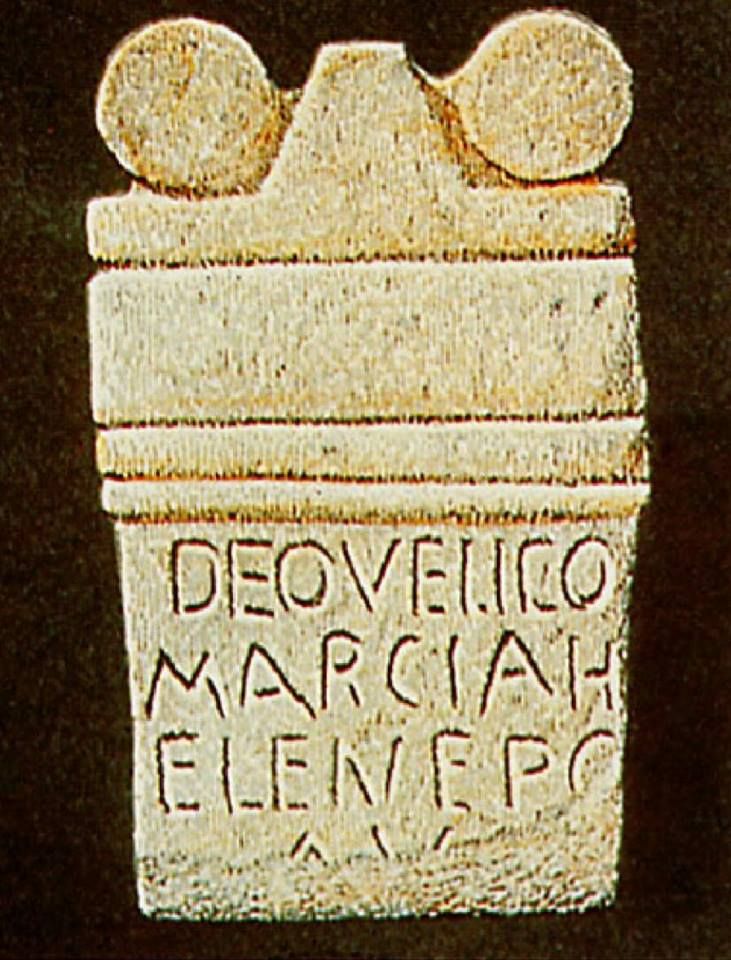
1. Meaning: The most accepted theory, is that it comes from Celtic vailos, “wolf”. I haven’t seen any expert address this, but if “vaelicus” comes from “vailos”, that’d imply it’s in adjectival form, so it would mean something like «wolfish» or «lupine». And with lots, lots of imagination, “lycanthrope”.
2. Other names and epithets: He appears as «DEO» in some of the epigraphy. Some believe this is just another name of Lusitanian Endovellicus, which is a theory quite on vogue lately, but I completely reject it because there are many details that they don’t quite fit in with the interpretation of Endovellicus as a wolf deity.*1
*1 According to these theories brought by Marco and Fernández Gómez, the difference between Endovellicus and Vaelicus, is that Endovellicus carries a superlative particle to imply his power or importance. Even though the original theories about Endovellicus’ name aren’t good enough, I think this one isn’t either for several reasons (and I’m no historian, so believe me at your own judgement, but I’m saying nothing other historians and experts haven’t said).
First and foremost: it seems there has been a huge interest in equating Endovellicus and Vaelicus since the beginning. So there’s some bias there. They certainly fulfill an almost equal role in their own societies, but I don’t think they are the same. They both have too many traits of a “numen loci”, but there is distance between them and even a change in the cultural paradigm (Endovellicus is Lusitanian and Vaelicus is Vettonian).
While Endovellicus was linked to Asclepius and asked for health, Vaelicus has no petitions “pro salutem”.
While Vaelicus is surrounded by circumstances that support the *vailo- theory, Endovellicus has no association with wolves that we know of.
While the Endovellicus as a wolf deity is associated to Sucellus because Sucellus was wearing wolfskin, the only representations known of Endovellicus has no wolf elements on them. Plus, Leite de Vasconcelos classified a sculpture (Endovellicus accompanied by 2 erotes, one holding a palm leaf, the other with a torch) he didn’t have anything lupine, nor the famous mallet, or anything associated to vines or wine as Sucellus is sometimes. Literally, Endovellicus and Sucellus share no iconography, so beyond their infernal nature, not sure what this comparison comes from.
Beyond not having wolf attributes of any kind, it is known Endovellicus was related to boars because of votive figurines given to him, and there is no previous case in which votive figurines aren’t straight up related to the god’s nature or personal mythology.
While Endovellicus is associated with healing and prophecy, having epithets of benevolence, Vaelicus seems not to share those practices or benevolent attributes (and nothing seems to indicate so, because even having into account the Saint Bernard thing, his specialty was healing rabies, which makes him more associated to wolves, than to health in general).
Linguistically, well, I’m no linguist, and I don’t know how important or not this could be, but we should note that in Endovellicus’ Latin epigraphy, the “l” doubles in most occasions, while in Vaelicus it doesn’t happen even once.
While in Vettonian epigraphy, one can see both «Vaelico» and «Velico», not once is seen «Endovaelico» or «Endovaellico”.
While you only have Vaelicus and Velicus, Endovellicus has drastic theonymic changes that are accepted as referring to same deity, including «Enobolicus».
3. Realm: Andumnos, given the mythemes of wolves in the Celtic world, as much as the closeness to waters and mines.
4. Interpretatio: None that is known. If understood as Endovellicus, Endovellicus was associated to Asclepius.
5. Iconography: None that is known. We can guess through anthropological thought and UPG, that wolf-related and warrior-related elements are both appropriate iconography*2
*2 I’ve got one single personal gnosis situation with Vaelicus, where I saw him in dreams. Vaelicus had a lycanthropic aspect in warrior clothes, helmet included, like an humanoid wolf, and holding something that I can’t remember if it was a sword or an axe. His eyes were red, and they observed me in a dark and liminal forest under a fullmoon, roaring (not howling), moving as a quiet shadow behind the trees to hide from my sight. His face shifted from mostly human to mostly lupine depending of the moment and the angle of sight, but his eyes never ceased to be glowing red. This scene didn’t go much further: I watched and observed, and my rational side was telling me it was him, and he is a god and I should not fear… but there was also a primitive instinct telling me I could be wrong. That maybe I wasn’t seeing a thinking god, but a monster that was about to rip me apart. That feeling lasted the whole dream, despite of the fact that he did nothing but watching me and hide behind trees, while I observed with my whole attention, admiration and awe.
6. Worship: Unknown, save vor the votive altars in Hispano-Roman period. It is most likely that he was the patron or tutelary deity of a warband, and that he was deemed to be the inductor of a battle fury. This battle fury would be like a trance, which the warrior most probably interpreted as lycanthropy, and the warrior would perceive as if he was possessed by a wolf, or even that he was shapeshifting into a wolf. It is possible that wolf characters in modern mask festivals are a reminiscence of his worship. A worship (or magic ritual) that would be based in the use of psychotropic plants, maybe drinking wolf or human blood, and wearing wolfskin and wolf masks.

7. Relationships: None that is known. As with Endovellicus, Ataecina by proximity.
8. Functions: Nocturnal god of initiated warriors. Inductor of lycanthropy. Psychopomp for his devotees fallen in battle, to whom he devours and regurgitate in the Underworld. Initiator in warbands. For women and non-warriors, maybe he provided healing for the rabies, and protection of household and flock against wolves*3
*3 His lupine functions are deduced from his etymology, *vailo, that is supported by various facts:
His sanctuary was in a place now called “Postoloboso” («loboso» it’s an adjective, kind of «wolfish»). It is well known the population of wolves was quite high in the area, back in the day.
Moreover, where his sanctuary was placed, an hermitage was built, devoted to the apochryfal saint, Saint Bernard of Candeleda. His sanctity was denied by the Church but reverred by the town, since he was said able to cure the rabies, an ailment usually transmitted by wolves and that in the past, it had suggestive names such as «wolf possession».
These miracles could be interpreted in 3 ways: a) that he was a «lobero» (literally «wolfer»), an European folk figure of men and women that wandered living amongst wolves as part of the pack and that offered protection against their own wolves and healing for wolf bites in exchange for food and a place to sleep b) that under Christian guise he was continuing a Pagan tradition of cult to Vaelicus and it would include the curing of rabies and healing of wolf bites c) a mythological way to declare the triumph of Christianity over Paganism, building an hermitage over his place of worship to bless it, and having this saint working against this god or unclean spirit that «possessed» people through bites, and healing them from their affliction (meaning: curing the rabid).

*4 19 epigraphic accounts were found here (all of them save for 1), dedicated by both genders, but mainly women. I add no actual example because all of them are classical Latin vow fulfillments.

——————————————————————————————————————————————-
Sources:
- Céltica Hispana [Laura Díaz].
- Hispania Epigraphica [Online Database].
- Aproximación a la Religión de los Vetones [Eduardo Sánchez Moreno].
- Diccionario de las Religiones Prerromanas de Hispania [José María Blázquez].
- Dioses de la Hispania Céltica [Juan Carlos Olivares Pedreño].
- El Registro Arqueobotánico de Plantas Psicoactivas en la Prehistoria de la Península Ibérica [Elisa Guerra Doce y José Antonio López Sáez].
- Herba Vettonica [Carlos G. Wagner].
- La Figura del Lobo y la Tradición Guerrera de la Hispania Céltica [Gonzalo Rodríguez García].
- Totemismo del Lobo, Rituales de Iniciación y Cuevas-Santuario Mediterráneas e Ibéricas [Julio González-Alcalde].